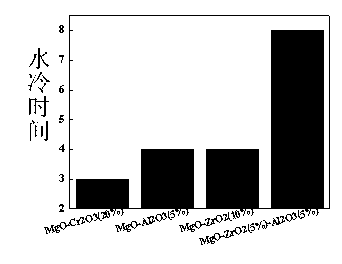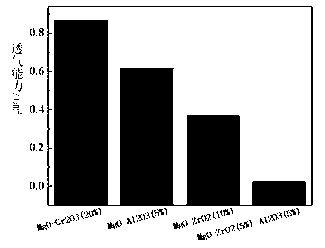Preparation method of magnesium spinet zirconium brick
A technology of magnesia spinel and zirconium bricks, which is applied in the field of preparation of magnesia spinel and zirconium bricks, can solve the problem of poor slag erosion resistance, unsatisfactory thermal spalling resistance and acid slag resistance of magnesia-zirconium bricks, magnesium tip Spar bricks have poor anti-scouring and anti-slag erosion performance, so as to achieve the effect of eliminating pollution
- Summary
- Abstract
- Description
- Claims
- Application Information
AI Technical Summary
Problems solved by technology
Method used
Image
Examples
Embodiment 1
[0020] 30% of 98 large crystal fused magnesia, 30% of α-Al 2 o 3 After the fine powder and 40% fused monoclinic zirconium are fully mixed, 1% pulp is added as a binder, pressed into a block at 200MPa, kept at 1720°C for 12 hours to burn the eutectic sand, and then the eutectic sand is ground to ≤0.0425 mm of fine powder, then use fused magnesia as aggregate, add 2.8% of eutectic fine powder and 1% of monoclinic zirconium powder, and keep sintering at 1720°C for 6 hours in an ultra-high temperature tunnel kiln to prepare a new type of magnesium For spinel zirconium bricks, the above ratios are all mass ratios. The chemical composition of the raw materials used in the test is shown in Table 1, and the composition of the samples is shown in Table 2.
[0021] Table 1 The chemical composition (w) of raw materials used in the test
[0022]
[0023] The batch composition (w) of table 2 sample
[0024]
Embodiment 2
[0026] It will be 30% of 98 large crystal fused magnesia, 30% of α-Al 2 o 3 After the fine powder and 40% fused monoclinic zirconium are fully mixed, 2% pulp is added as a binder, pressed into a block at 200MPa, kept at 1760°C for 13 hours to burn the eutectic sand, and then the eutectic sand is ground to ≤0.0425 mm of fine powder, then use fused magnesia as aggregate, add 3% of eutectic fine powder and 2% of monoclinic zirconium powder, and burn it in an ultra-high temperature tunnel kiln at a temperature of 1720°C for 6 hours to prepare a new type of magnesium For spinel zirconium bricks, the above ratios are all mass ratios. The chemical composition of the raw materials used in the test is shown in Table 1, and the composition of the samples is shown in Table 2.
Embodiment 3
[0028] It will be 30% of 98 large crystal fused magnesia, 30% of α-Al 2 o 3 After the fine powder and 40% fused monoclinic zirconium are fully mixed, 3% pulp is added as a binder, pressed into a block at 200MPa, kept at 1815°C for 14 hours to burn the eutectic sand, and then the eutectic sand is ground to ≤0.0425 mm of fine powder, then use fused magnesia as aggregate, add 3.5% of eutectic fine powder and 3% of monoclinic zirconium powder, and burn it in an ultra-high temperature tunnel kiln at a temperature of 1720°C for 6 hours to prepare a new type of magnesium For spinel zirconium bricks, the above ratios are all mass ratios. The chemical composition of the raw materials used in the test is shown in Table 1, and the composition of the samples is shown in Table 2.
[0029] The new magnesia spinel zircon brick (MAZ) and spinel brick (MgO-Al 2 o 3 (MA)) and magnesia-zirconium bricks (MgO-ZrO 2 (MZ)) for performance comparison, see Table 3 and Figure 1-Figure 3 .
[00...
PUM
| Property | Measurement | Unit |
|---|---|---|
| particle size | aaaaa | aaaaa |
| particle size | aaaaa | aaaaa |
Abstract
Description
Claims
Application Information
 Login to View More
Login to View More - Generate Ideas
- Intellectual Property
- Life Sciences
- Materials
- Tech Scout
- Unparalleled Data Quality
- Higher Quality Content
- 60% Fewer Hallucinations
Browse by: Latest US Patents, China's latest patents, Technical Efficacy Thesaurus, Application Domain, Technology Topic, Popular Technical Reports.
© 2025 PatSnap. All rights reserved.Legal|Privacy policy|Modern Slavery Act Transparency Statement|Sitemap|About US| Contact US: help@patsnap.com



